

Posted on 07/11/2005 5:04:13 AM PDT by Republicanprofessor
So we have studied Cubism, Expressionism and Surrealism in Europe. What was happening in America? At first, as we saw earlier, the American Ash Can School thought they were the most modern school. They sponsored the Armory Show in 1913 and brought over the Europeans from Cezanne through Kandinsky, and as a result the American works looked a bit backward.


Robert Henri Snow in NY 1902 and Kandinsky Improvisation 28 1912
But some Americans were intrigued by the Armory show, and a few knew about European modernism before 1913. In fact, the famous photographer Alfred Stieglitz pioneered more than just photography. In the first decade of the new century, he started a gallery called “291” (from its address on Fifth Avenue). This was the very first modern art gallery in NYC; and he brought over works by Cezanne and many others, including watercolors by Rodin.

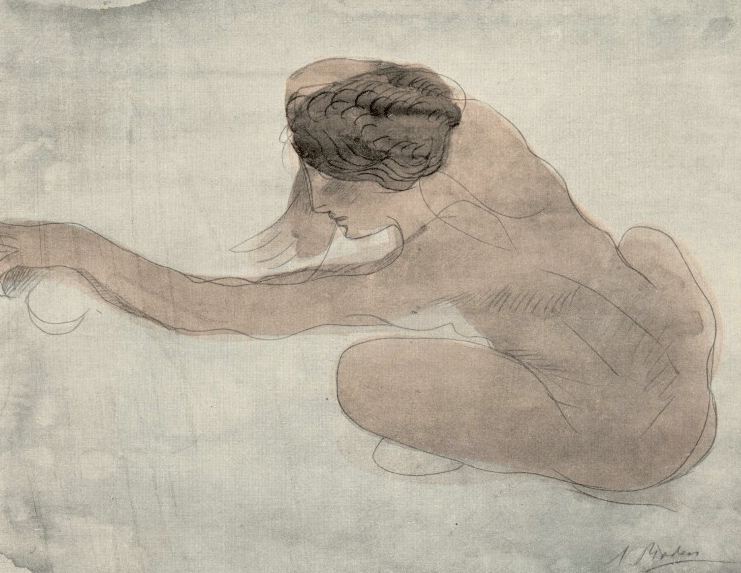
Stieglitz, one of his many images of Georgia O’Keeffe and one of Rodin’s watercolors
Soon he gathered a group of artists around here, and these artists can be referred to as the Early American Modernists or the Stieglitz Group. He had an amazing eye, and in 1917 he was shown the early watercolors of Georgia O’Keeffe (purportedly saying that he had finally seen “a woman on canvas”). (See the images below.) He also supported and exhibited the works of Arthur Dove, Marsden Hartley, John Marin and many more.
Now, my question to all of you is this: how have these American artists taken and absorbed the ideas of Cubism, Expressionism and even Surrealism to make an unique style of American art? What content do the Americans add to these styles to reflect quintessentially American history and values?


Dove Nature Symbolized c. 1911 and his Me and the Moon1937
Arthur Dove (1880-1946) was one of the first in the WORLD to explore non-objective art. (That’s art without an object from which to “abstract.".) He actually called his works “concretions” because he didn't like the word "abstraction." His Nature Symbolized #2 reflects the American landscape in pastel, with Cubist planes and perhaps some Expressionistic emotion. I see this as reflecting a hill with pine trees (or other trees) on a very windy day. But others could just as easily see other things. Me and the Moon was actually inspired by swing music of that decade. Dove also lived on a house boat for many years, so I think he captured the effect of waves and fog very well.
I also love the work of Marsden Hartley (1887-1943). He never really found a home, emotional or otherwise. He went to Germany in 1913 and did these incredibly powerful abstractions glorifying the marching German army before WWI. One of these has many hidden symbols and is a memorial to one soldier he loved, Karl von F. The flat power of these works is just as advanced as the Cubists (who were just beginning Synthetic Cubism as this time) and the German Expressionists. In fact, he exhibited with Kandinsky, Marc and the Blue Rider.


Portrait of a German Officer 1914 and his 1914Indian Fantasy, which is one of the American works of the time that are less well known.
So, how do you think the American public liked the German works when they were exhibited in 1913 and 1914? Perhaps they felt a bit as we feel about Saddam Hussein’s palaces now (except that the latter are much tackier and not exactly on the “cutting” edge…unless you consider what he did to his own people to get so wealthy…but that’s another story). When his exhibitions flopped, Hartley retired to Provincetown and did more quiet works. Later, he went to Maine and came as close to a “home” as possible. But, again he was dogged by personal tragedy. The fisherman he fell in love with was also killed at sea. At this point, his more representational work is more in line with the more conservative depression-era Regionalism of the time, like that of Benton, Wood, and others. But I still love his images of Mt. Katahdin and the ocean (as well as the fisherman, but I couldn't easily find an image of that.)

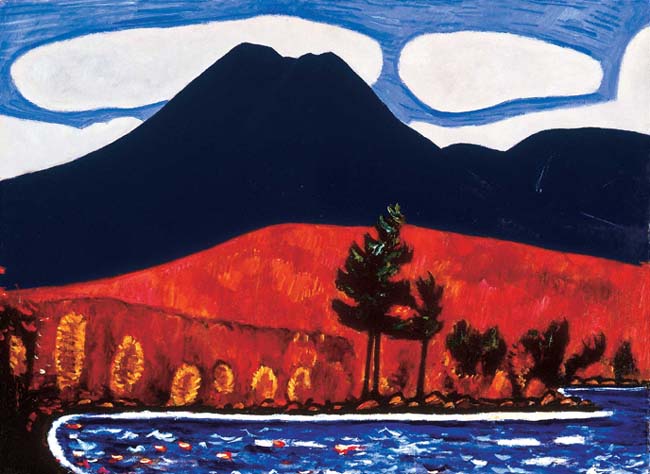

Hartley Provincetown Abstraction 1916 Mt. Katahdin 1939-40 Thomas Hart Benton Ballad of the Jealous Lover
Another strong American Modernist is John Marin (1870-1953). His work is cubist, but he keeps more integrity of the objects. His work in watercolor is awesome, and I especially like the works done from Stonington, Maine.


John Marin Brooklyn Bridge Fantasy and his Schooner Yachts, Deer Isle, Maine 1928
Georgia O’Keeffe (1887-1986), although many years younger than Stieglitz, married Stieglitz in the twenties. Her early watercolors are some of her finest works. Evening Star reminds me of a sunset over water. She is infamous, of course, for her flower images. She blew them up big because she felt that no one ever noticed flowers. The Jack in the Pulpit series shows how she moved progressively toward abstraction in this.



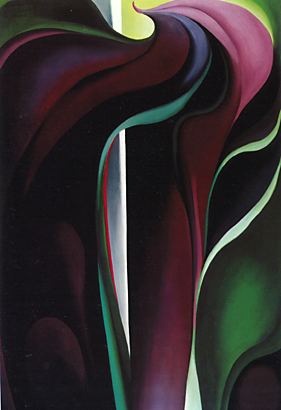
O’Keeffe Evening star IV 1917 Jack in pulpit III, Jack in pulpit IV, and Jack in pulpit V
Later, she moved to Taos, NM. Her works of skulls capture the beauty and deathly power of the dessert.

I would also like to include the Precisionists here, although they are not part of the Stieglitz group. Charles Demuth (1883-1935) did some fascinating, abstract portraits of many, including William Carlos Williams, as in the very famous Number 5 in Gold, below. This is from a short, imagist poem by Williams about a firetruck:
The Great Figure
Among the rain
and lights
I saw the figure 5
in gold
on a red
fire truck
moving
tense
unheeded
to gong clangs
siren howls
and wheels rumbling
through the dark city
William Carlos Williams (1883-1963)
Sour Grapes: A Book of Poems
Four Seas Company, Boston, 1921

Can you see the images in the painting, plus the cryptic references to WCW? Like Marin, Demuth was inspired by Cubism, but his objects also remain intact. Another favorite is My Egypt, below, which gives the same monumental power to our industrial and agricultural forms as Egypt’s pyramids are renown for. (If someone can tell me exactly what these forms are, I’d appreciate it. They look like grain elevators to me, but I’m not certain.) Note how much whole the images are than in Braque's cubist work. Demuth lays rays of light over the solid images. The rays are almost like spotlights in some works.

 Demuth My Egypt vs. Frenchman Braque’s cubist Violin and Pitcher
Demuth My Egypt vs. Frenchman Braque’s cubist Violin and Pitcher
The last precisionist of importance was Charles Sheeler (1883-1965). He, too, was influenced by Cubism, as you can see in the powerful play of flat planes. However, he kept his objects very whole indeed. Can you tell why Sheeler and Demuth are called Precisionists? Not only is their work very precisely rendered, with firm lines and shapes and a good deal of realism. But they also celebrated the utopian view of factories as our salvation. These images of the River Rouge plant in Detroit are powerful. This is where the Model A was manufactured, with the raw materials (iron, sand, etc.) going in one end and out the other came a complete car. Very different assembly than you see today, when the various small parts are delivered just in time to be installed.
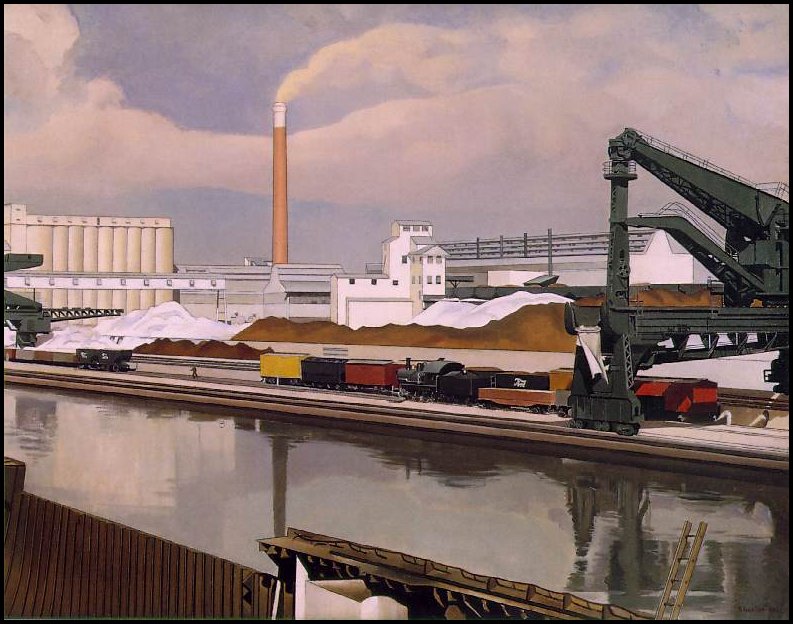
Sheeler River Rouge plant seen in American Landscape 1930
Diego Rivera (1886-1957), the Mexican socialist painter, was also intrigued by the River Rouge plant and some of his awesome murals are at the Detroit Institute of the Arts, see below. Of course, his mural of Man at the Crossroads (on the right below) was jack-hammered off the wall at Rockefeller Center because of the inclusion of Lenin. Even though I don’t agree with him politically, I do like his work. And I liked the movie Frida done of his lover and wife, Frida Kahlo.



Rivera, Detroit and Rockefeller murals and detail of the latter.
I also highly recommend Ed Harris’ movie Pollock before our next “class,” perhaps as a summer film. Ed Harris worked 8 years from research to the script to acting and directing this film. I’ve done a great deal of work on Pollock myself, and all the stories that I knew about (including the ruinous dinner), were all true to life. He was a troubled man who really made a breakthrough in art. I’ll get to this next time, either within a week or at the end of August.
Art ping.
Let Sam Cree or I know if you want on or off this list.
Art Appreciation/Education ping.
Let me know if you want on or off this ping list.
I noticed that you enjoyed Liz's art pings.
Let me know if you want to be added to one or both of the other ping lists (art ping: general art articles; or art appreciation/education lists for these kind of "lectures.")
I look forward to your piece on Pollock. I saw the movie with Ed Harris. It was excellent and I urge everyone to rent it. It's not a romanticization of an artist's life like the movie depictions of Toulouse-Lautrec or other painters we've seen in the past. Very nitty-gritty, but gripping. Harris gives a great performance.
Leni
I just love the works of Thomas Hart Benton. I'm also a big fan also of the WPA artists whose works depicted everyday people going about their lives. Thanks for the class, Professor.

My first impression as I scrolled down to this picture was of the crucifixion, with the upper flower being Christ's thorn-crowned head hanging down.
Your series has been fun and informative. I appreciate the effort.
As I scrolled down through the images and saw the Robert Henri painting, I thought that the work of Edward Hopper would pop up (Hopper was a student of Henri in NY).
Even though he studied for several years in Paris during the time of Picasso and Matisse, Hopper returned to New York to create some quintessentially American paintings. Nighthawks comes to mind.
Hopper's cultural influnce was found manifest in the film noir genre and even Hitchcock's Psycho.
Oh, and he was a staunch conservative as well (this is FreeRepublic after all).
One minor grammatical quibble - Georgia O’Keeffe is not "infamous, of course, for her flower images." O'Keefe is not infamous at all. She's famous for her flower images.
There's a painter in Nashville Indiana (I think) Carson? Carstairs? Something like that, who does work similar to Sheelr. Starts with pen and ink and then colors the design. Very good looking pictures, lots of Amish type scenes and farm /city scenes from 1910's or 20's.
I remember a funny point from the bonus part of the film. Ed Harris said that the times when he was painting like Pollock were interesting. The times he thought the painting turned out good looked poor on the film; and the times the painting was horrible was the time the filming of the painting went well. Then, if you add in the Hans Namuth filming of Pollock, and his stopping Pollock mid-stream (so to speak), you get several different levels to film and reality.
I was leary of this film at first. I thought I'd see Ed Harris, and not Pollock, through the whole thing. I hate films on art when it seems so faked. But in the first few seconds, Harris got this look on his face that was exactly like Pollock. I was sucked in immediately and impressed by the entire film.
That's why I love abstraction. The visual forms work on so many different levels.
I don't know how traditionally religious O'Keeffe was, but who knows what lurks at our subconscious. I certainly feel a spiritual power in all these artists' works, but it is not one linked to traditional religion. It is one that raises our spirits and connect us to the spirit in nature.
Infamous, famous. Right you are. I think there is another grammatical error in there too, but I couldn't find it again to fix it before I posted the essay.


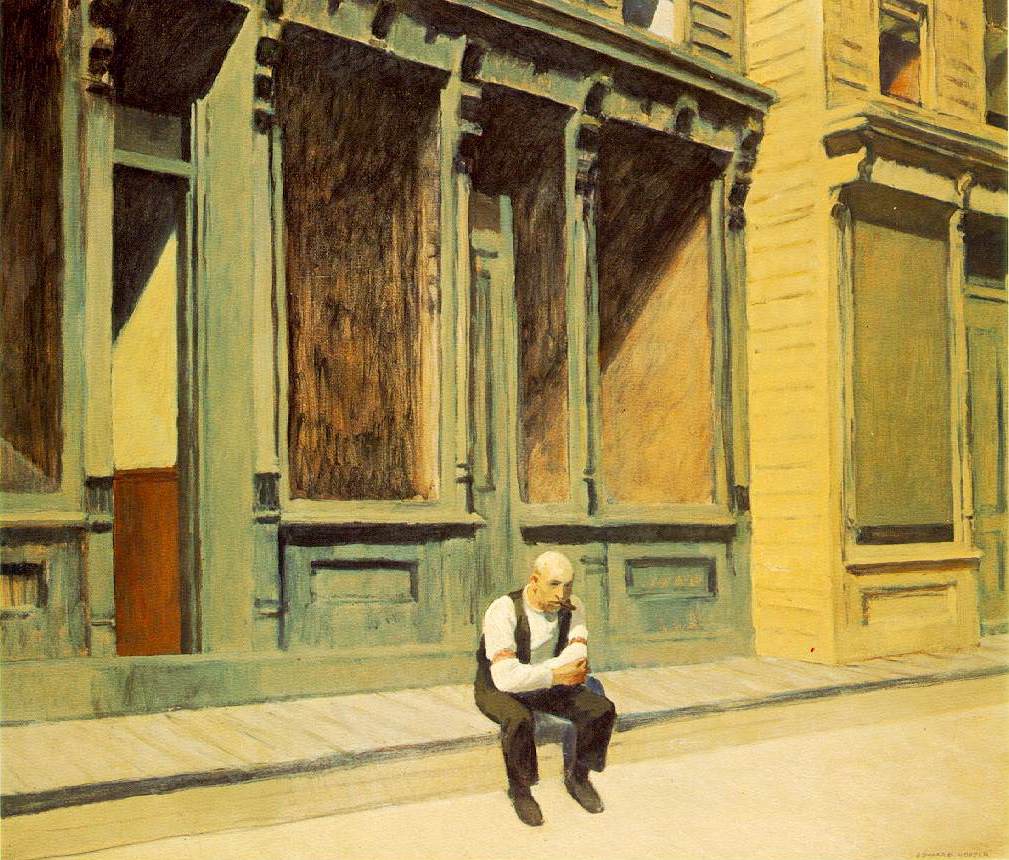

Hopper Summertime 1943 and Sunday Morning and Early Sunday Morning 1930
She seems to be waiting for someone, but I don't think it's the guy in the next painting (which is almost a sequel to the more famous--not infamous--Early Sunday Morning). The date on Summertime, 1943, may suggest that most of the men are away at war. And, in regard to Early Sunday Morning, there used to be a figure in one of the upper apartment windows, but he painted it out. Maybe it was lonely enough without the figure?
The sense of loneliness that I feel in Hopper's work, is often mitigated by the beautiful light therein. But his people seem so isolated and alone. I guess that was his vision of the human existence. (And he was married too. His wife Jo was often the model for the nudes in his works, even when she was close to 70 and the figures in the paintings seemed much younger.)
I think I used that word because many critics saw something X-rated in her flower images. I don't know if I need to get much more explicit on FR about that.
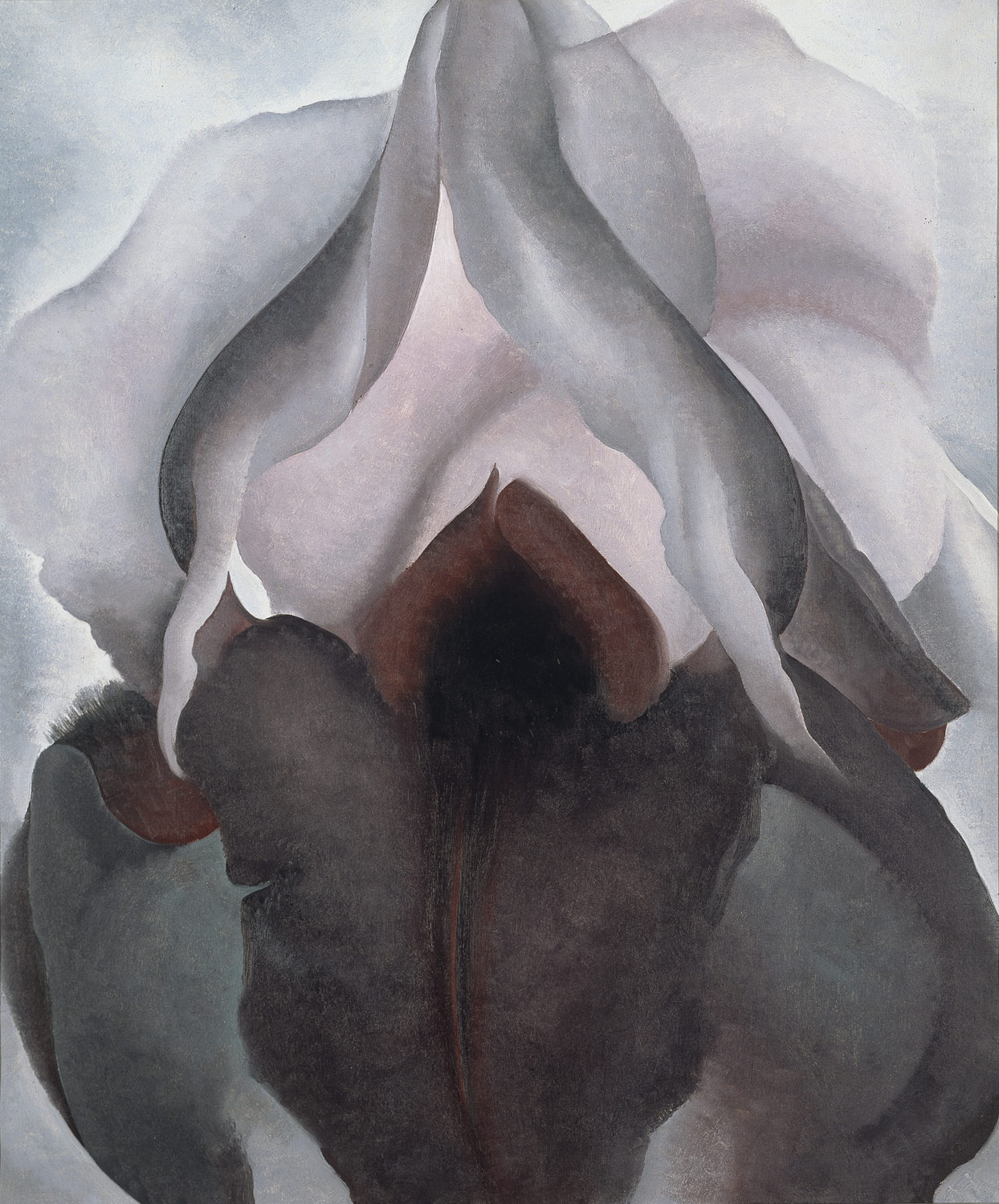
Black Iris 1926
I like his work too, probably more so since I learned that he usually combines different photos of the scene into the final painting.
I am less impressed with the artists who project a slide onto their canvas and then paint from that.
I've heard that, but it always seemed a stretch to me. The same bluenoses who saw gay propaganda in Batman & Robin.... ;)
Still, not sure that rises to the level of infamy. A minor quibble, to be sure, and not to in any way detract from your lectures. Thanks again!
Hopper is one of my favorites too. I started liking him after seeing a painting, "Groundswell," on one of Republican Professor's art ed threads.
I even printed it out from my computer so I could show it around in awe.
Made the mistake of showing it to my sister in law the other day, who pronounced it crap, saying that her 26 year old son in law is better. Actually her son in law is a talented amateur artist - who knows what he could become if he devoted himself to art? But there have not been many artists on Hoppers level.
Disclaimer: Opinions posted on Free Republic are those of the individual posters and do not necessarily represent the opinion of Free Republic or its management. All materials posted herein are protected by copyright law and the exemption for fair use of copyrighted works.